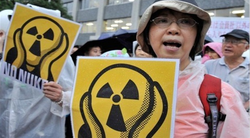 Published on 28 July, 2011. Author: Alessia Cerantola IWAKI, Japan – When the screen starts lightning Kaori Suzuki turns the dosimeter towards her friends and announces the result of the latest measurements. The screen reads 0,171 microsieverts per hour, a level under control. Seated at a table with a cup of tea and dosimeters in one hand, a scattering of young to middle aged women takes notes of the data and compares them with the ones from previous days. Since May, these meetings have been happening more and more frequently with the goal of checking for radioactivity levels in Iwaki, a city 30 miles from the crippled Fukushima Daiichi nuclear power plant. It was some months after the reactor meltdown when mothers of Iwaki gathered together to measure by themselves the level of radioactivity. Worried by uncertain and doubtful information given by the government, they saved and collected 600 dollars to buy the first Geiger counter and measure the radiation level. The group now consists of 15 people and an increasing number of amateurs, including fathers and grandmothers, who take part in activities and meetings. They call themselves “Action Mamas” and meet at restaurants and taverns, or at the local office of the Ishinomaki city’s daily newspaper Hibi Shimbun, whose reporters are known because they used flashlights and marker pens to write their stories on poster-size papers for six consecutive days after the disasters. “The economy and our children’s health run on opposite tracks. We want to protect our children and our families, without leaving this place,” said Mrs. Suzuki. “Although we don’t live far from the 12-mile evacuation zone around the stricken
Fukushima nuclear reactor, the radiation level is not so high compared to Chiba Prefecture. But we can’t just be restricted to this data.” They are not convinced by the government’s decision to raise the maximum limit of safe radiation exposure from one to 20 millisieverts per year, and the fact that this adult-sized dose has been extended also to children keeps causing debates among experts and citizens. Also, the new standard sets a maximum level of 200 becquerels per kilogram for milk and derivates, while rice and vegetables with up to 500 becquerels is considered safe for consumption. “Inconceivable! It means that Japanese children can tolerate a higher level of radioactivity than other children around the world? We claim that people really understand the meaning of measurements and data and, if safe, we want to keep staying here and coexist with what is called the invisible enemy.” With the help of some humanitarian associations, the Action Mamas are organizing summer outings for children in other green parts of Japan, and are also arranging meetings with radiation experts. Being aware that the situation that is still likely to deteriorate, they demand to local administrations to provide periodical blood and urine checkups. Also, groups of parents are sent to the nearby city of Fukushima to learn from technicians about how to protect against radiation and how to handle complex instruments to measure food contamination. Thanks to donations they managed to buy the first of these instruments, worth 3 million yen (almost $40000). Apart from the Action Mamas, other people in Iwaki choose to gather information by themselves and restart their business. The farmers of this Japan’s fourth-biggest rice producer region discuss whether to abandon planting rice and vegetables in tainted soil. “Since the disaster at the Fukushima plant I’m not selling anything,” said Ryoko Namatane showing his 1.0 hectare rice and vegetable field. In May, Japanese authorities declared this area safe, but scared by news from the media, many people started buying at the supermarket instead of at family markets, carefully checking the place of origin. Farmers can’t determine how much cultivation can be eaten until the harvest. “I like that my nephews keep using my vegetables as they have done so far. But, how can I make them eat a 495 becquerels cesium tainted carrot?” Despite the fall out of the local tourism sector in March, some of Iwaki’s businessmen have decided to reinvest in the area. After the 3.11 and the 4.11 strong earthquakes, the tsunami and the Fukushima explosion, tourism was suddenly destroyed in a city with over 7.5 million visitors per year. But in October 2011 the leisure complex Resort Hawaiians is expected to open part of its spa and pools to the public. In June the 2,050 cubic meters aquarium Acquamarine Fukushima, one of the most attractive facilities of the region, was reopened. “The number of visitors has roughly halved”, said the director Yoshitaka Abe. “But it is my intention to turn this place into a symbol of Iwaki’s renaissance”.
1 Comment
Edoardo Quiriconi
2/28/2015 10:39:15 am
Gentile Dr.ssa Cerantola,
Reply
Your comment will be posted after it is approved.
Leave a Reply. |
Archives
August 2023
|
 RSS Feed
RSS Feed
